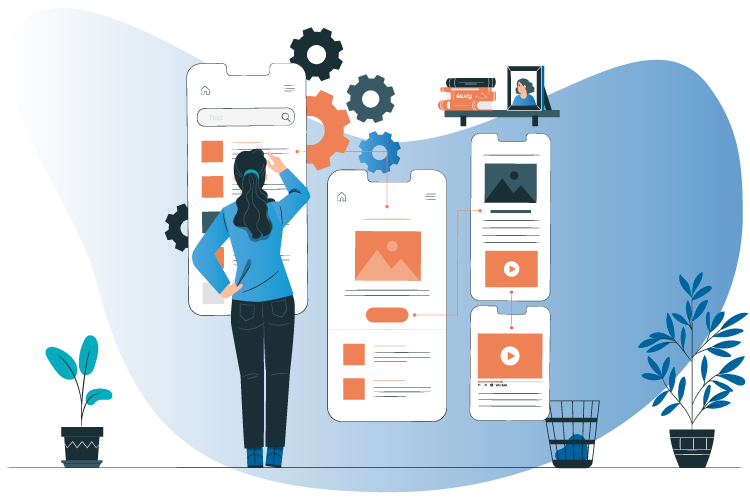
M Mobile apps are all unique in their way: they dissent in complexity, functionality, and expected use. Because of this variety, there’s no universal procedure for mobile app development. There are standard steps for diverse projects that represent the app development process on the whole.
Mobile apps are all unique in their way: they dissent in complexity, functionality, and expected use. Because of this variety, there’s no universal procedure for mobile app development. There are standard steps for diverse projects that represent the app development process on the whole.
Define the specific
To make your app idea material, you require to describe it in technical terms. That is, you have to place the app idea into specific categories based on three foremost factors:
- Target platform
Select whether you want to provide an app to the iOS app development, Android, or Windows Phone audience. If you are going to operate diverse platforms, set your preferences, and determine the market you want to join first.
- Development type
If you’ve chosen a single platform in the previous question, you should most likely go native. If you consider catering to both markets, look into cross-platform and hybrid opportunities.
- Monetization model
Consider the way you desire your app to make a profit. You can ask your users to pay to install the app, earn money from advertisements or in-app shopping. Until recently, the last option was conventional for Android apps only, but in-app micro-transactions have been effective, and they are now encouraging many successful iOS apps.
Get your bearings
At this level of the mobile app development process, review your prospective opponents by studying the apps based on concepts that mirror yours. No implementation can accurately say what you imagined about, but most possibly, very comparable apps already exist. Please don’t allow that to depress you; instead, take benefit of it.
Examine related apps to learn better what you require and don’t your app to be. Consider the users’ rating: what do they demand from an app similar to yours? What are they annoyed with? What changes do they recommend? With these insights, your app can incorporate the entire most reliable component that already exists in the market and have a jump-start by submitting a thought-out solution.
Design your vision
Before you redirect to a professional UI/UX designer or application developer, attempt to recreate your vision of the ultimate app, you can make it on paper by outlining your app’s mainframes and recording required information about button actions and animations. But for greater comfort and effectiveness, you can use simple prototype tools available. It doesn’t require any coding knowledge. Since it is possible to assign actions to the navigation elements and adjust transitions, all you need to do is drag and drop pre-made UI elements on your app’s virtual mock-up model. You can interact with a prototype of your app and see it live.
Search for developers
Discovering a mobile team to execute your concept is the most significant step in the app development process. To deliver your app into the best hands, carry careful research of your possible business partner. Primarily, take into deliberation:
- Mobile development expertise
- Technology works
- Business focus
- Customer recommendations
- Case studies and demos
Don’t execute a snap decision and take your time to approach 7-10 businesspeople.
Guide and Cooperate
You don’t remove yourself from responsibility even after finding and hiring a vendor for your app development. If you desire to get a fabulous app in the end, you should continue managing the application side by side with the developers.
Do you want to participate in the project as little as possible, or would you prefer to keep up with the progress?
Review the amount, design, and cycle of your interaction with the developers. To ensure you both understand how much you are going to be concerned. Be adapted to dedicate some of your time to give great feedback during UI/UX design, development, and testing phases.
Get the app published.
Except you develop an app that you need to combine with the in-house systems, the app development process’s next level is publishing the app on a store. Since app stores have particular quality standards and security conditions, you’ll be on the secure side if you approve of releasing them to your developers. The store’s permission for publishing the app will be the ultimate quality assurance test they have to pass.
Further maintenance
You can never say your app is ‘perfect,’ not even after its publication. There is a continual opportunity for extension and development, so you’ll probably require your app to have routine maintenance and updates. By continuously working on your app with the development team, you’ll be capable of keeping its content and designing relevant. Depending on your app’s nature, you may require a constant tech support team to detect any technical difficulties and fix them immediately.
Summary
Although each project is different, the mobile app development process forever comprises a sequence of steps outlined above. To make your app from a fresh idea to a fabulous product, you have to decide on its technical aspects, investigate the market, communicate your design and UI architecture visions and, ultimately, jointly cooperate with developers throughout the development, testing, and maintenance phases.


